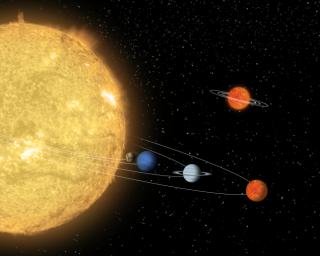
|
Itsy Bitsy Solar System (Artist’s Concept)
- Click the image above for a larger view
- Full-Res JPEG (3000 x 2400) (393.8 kB)
- Full-Res TIFF (3000 x 2400) (21.6 MB)
Caption:
This artist's conception compares a hypothetical solar system centered around a tiny "sun" (top) to a known solar system centered around a star, called 55 Cancri, which is about the same size as our sun. NASA's Spitzer Space Telescope, in combination with other ground-based and orbiting telescopes, discovered the beginnings of such a miniature solar system 500 light-years away in the Chamaeleon constellation.
The tiny system consists of an unusually small "failed" star, or brown dwarf called Cha 110913-773444, and a surrounding disk of gas and dust that might one day form planets. At a mass of only eight times that of Jupiter, the brown dwarf is actually smaller than several known extrasolar planets. The largest planet in the 55 Cancri system is about four Jupiter masses.
Astronomers speculate that the disk around Cha 110913-773444 might have enough mass to make a small gas giant and a few Earth-sized rocky planets, as depicted here around the little brown dwarf.
Cataloging Keywords:
| Name | Value | Additional Values |
|---|---|---|
| Target | 55 Cancri | |
| System | 55 Cancri | |
| Target Type | Exoplanet | |
| Mission | Spitzer Space Telescope | |
| Instrument Host | Spitzer Space Telescope | |
| Host Type | Space Telescope | |
| Instrument | ||
| Detector | ||
| Extra Keywords | Artwork, Color, Disk, Dust, Infrared, Orbit | |
| Acquisition Date | ||
| Release Date | 2005-11-29 | |
| Date in Caption | ||
| Image Credit | NASA/JPL-Caltech | |
| Source | photojournal.jpl.nasa.gov/catalog/PIA03604 | |
| Identifier | PIA03604 | |
